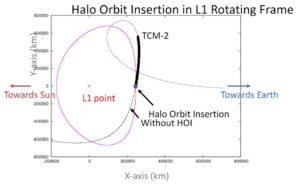The News Freedom
New Delhi, January 6
India achieved a significant milestone as its first solar observatory, Aditya-L1, reached its final destination orbit, positioned approximately 1.5 million kilometers from Earth. This accomplishment, known as the Halo-Orbit Insertion (HOI), was successfully executed at 4 pm on Saturday. The maneuver involved a brief firing of control engines, settling Aditya-L1 into a periodic Halo orbit that maintains a continuous view of the Sun while revolving along the Sun-Earth line, completing an orbital cycle approximately every 177.86 earth days.
Prime Minister Narendra Modi hailed ISRO for the achievement and praised the dedication of Indian scientists in realizing this complex space mission. In his post on X, he emphasized India’s commitment to exploring new scientific frontiers for the betterment of humanity.
India creates yet another landmark. India’s first solar observatory Aditya-L1 reaches it’s destination. It is a testament to the relentless dedication of our scientists in realising among the most complex and intricate space missions. I join the nation in applauding this…
— Narendra Modi (@narendramodi) January 6, 2024
Aditya-L1’s mission focuses on observing and understanding the Sun’s chromospheric and coronal dynamics. Positioned at Lagrangian point L1, this solar observatory’s halo orbit offers advantages over Low Earth Orbit (LEO), facilitating continuous solar observations and enabling “in situ” sampling of the solar wind and particles. Additionally, it ensures uninterrupted communication with ground stations while providing an unobstructed view of the Earth.
The successful insertion into the Halo orbit demonstrates the precision and control required for such critical maneuvers. It underscores ISRO’s capabilities in managing intricate orbital operations, instilling confidence for future interplanetary missions.
Designed and developed at UR Rao Satellite Centre (URSC) with contributions from various ISRO centers, Aditya-L1 carries payloads developed by Indian scientific laboratories. Launched aboard PLSV-C57 on September 2, 2023, the spacecraft gradually expanded its orbit through a series of liquid engine burns (LEB) during the Earth orbit phase, culminating in the trans-L1 injection (TL1I) maneuver. Carefully strategized to minimize fuel consumption and radiation exposure, this trajectory led Aditya-L1 towards its targeted L1 halo orbit.
The visual representation below illustrates the Halo orbit insertion process, showcasing Aditya-L1’s journey towards aligning with the Halo Orbit through precisely timed engine firings. This critical maneuver ensures optimal fuel usage and spacecraft alignment for its scientific mission.

